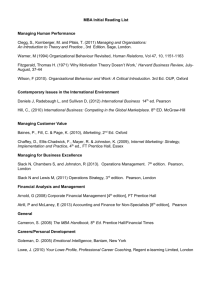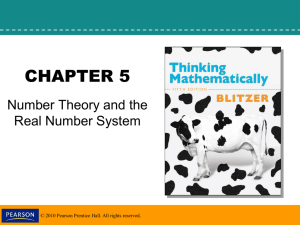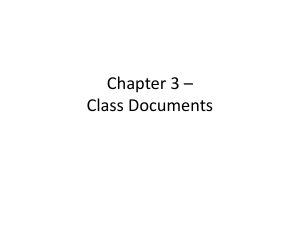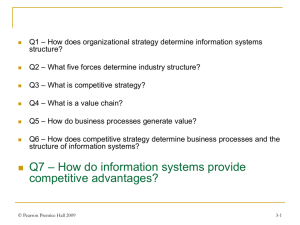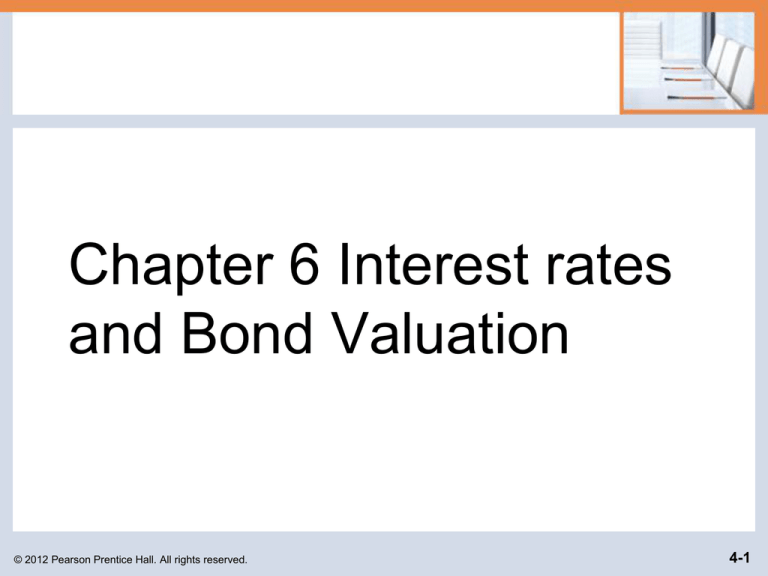
Chapter 6 Interest rates
and Bond Valuation
© 2012 Pearson Prentice Hall. All rights reserved.
4-1
Interest Rates and Required Returns:
Interest Rate Fundamentals
The interest rate is usually applied to debt instruments such
as bank loans or bonds; the compensation paid by the
borrower of funds to the lender; from the borrower’s point
of view, the cost of borrowing funds.
The required return is usually applied to equity
instruments such as common stock; the cost of funds
obtained by selling an ownership interest.
© 2012 Pearson Prentice Hall. All rights reserved.
6-2
Interest Rates and Required Returns:
Interest Rate Fundamentals
Several factors can influence the equilibrium interest
rate:
1. Inflation, which is a rising trend in the prices of most
goods and services.
2. Risk, which leads investors to expect a higher return
on their investment
3. Liquidity preference, which refers to the general
tendency of investors to prefer short-term securities
© 2012 Pearson Prentice Hall. All rights reserved.
6-3
Interest Rates and Required
Returns: The Real Rate of Interest
The real rate of interest is the rate that creates equilibrium
between the supply of savings and the demand for
investment funds in a perfect world, without inflation,
where suppliers and demanders of funds have no liquidity
preferences and there is no risk.
The real rate of interest changes with changing economic
conditions, tastes, and preferences.
© 2012 Pearson Prentice Hall. All rights reserved.
6-4
Interest Rates and Required Returns:
Nominal or Actual Rate of Interest (Return)
The nominal rate of interest is the actual rate of interest
charged by the supplier of funds and paid by the
demander.
The nominal rate differs from the real rate of interest, r* as a
result of two factors:
– Inflationary expectations reflected in an inflation premium (IP),
and
– Issuer and issue characteristics such as default risks and
contractual provisions as reflected in a risk premium (RP).
© 2012 Pearson Prentice Hall. All rights reserved.
6-5
Interest Rates and Required Returns:
Nominal or Actual Rate of Interest (cont.)
For the moment, ignore the risk premium, RP1, and focus exclusively
on the risk-free rate. The risk free rate can be represented as:
RF = r* + IP
The risk-free rate (as shown in the preceding equation) embodies the
real rate of interest plus the expected inflation premium.
The inflation premium is driven by investors’ expectations about
inflation—the more inflation they expect, the higher will be the
inflation premium and the higher will be the nominal interest rate.
© 2012 Pearson Prentice Hall. All rights reserved.
6-6
Term Structure of Interest
Rates
The term structure of interest rates is the relationship between the
maturity and rate of return for bonds with similar levels of risk.
A graphic depiction of the term structure of interest rates is called the
yield curve.
The yield to maturity is the compound annual rate of return earned on
a debt security purchased on a given day and held to maturity.
• http://stockcharts.com/charts/yieldcurve.html
• This website shows the relationship between the
yield curve and the S&P 500 stock index.
© 2012 Pearson Prentice Hall. All rights reserved.
6-7
Figure 6.3
Treasury Yield Curves
© 2012 Pearson Prentice Hall. All rights reserved.
6-8
Term Structure of Interest
Rates: Yield Curves (cont.)
A normal yield curve is an upward-sloping yield curve
indicates that long-term interest rates are generally higher
than short-term interest rates.
An inverted yield curve is a downward-sloping yield curve
indicates that short-term interest rates are generally higher
than long-term interest rates.
A flat yield curve is a yield curve that indicates that interest
rates do not vary much at different maturities.
© 2012 Pearson Prentice Hall. All rights reserved.
6-9
Corporate Bonds
A bond is a long-term debt instrument indicating that a corporation
has borrowed a certain amount of money and promises to repay it in
the future under clearly defined terms.
The bond’s coupon interest rate is the percentage of a bond’s par
value that will be paid annually, typically in two equal semiannual
payments, as interest.
The bond’s par value, or face value, is the amount borrowed by the
company and the amount owed to the bond holder on the maturity
date.
The bond’s maturity date is the time at which a bond becomes due and
the principal must be repaid.
© 2012 Pearson Prentice Hall. All rights reserved.
6-10
Corporate Bonds: Legal
Aspects of Corporate Bonds
The bond indenture is a legal document that specifies both the rights
of the bondholders and the duties of the issuing corporation.
Standard debt provisions are provisions in a bond indenture
specifying certain record-keeping and general business practices
that the bond issuer must follow; normally, they do not place a
burden on a financially sound business.
Restrictive covenants are provisions in a bond indenture that place
operating and financial constraints on the borrower.
© 2012 Pearson Prentice Hall. All rights reserved.
6-11
Corporate Bonds: Legal Aspects of
Corporate Bonds (cont.)
Subordination in a bond indenture is the stipulation that subsequent
creditors agree to wait until all claims of the senior debt are
satisfied.
Sinking fund requirements are a restrictive provision often included
in a bond indenture, providing for the systematic retirement of
bonds prior to their maturity.
A trustee is a paid individual, corporation, or commercial bank trust
department that acts as the third party to a bond indenture and can
take specified actions on behalf of the bondholders if the terms of
the indenture are violated.
© 2012 Pearson Prentice Hall. All rights reserved.
6-12
Corporate Bonds:
Cost of Bonds to the Issuer
In general, the longer the bond’s maturity, the higher the
interest rate (or cost) to the firm.
In addition, the larger the size of the offering, the lower
will be the cost (in % terms) of the bond.
Also, the greater the default risk of the issuing firm, the
higher the cost of the issue.
Finally, the cost of money in the capital market is the basis
form determining a bond’s coupon interest rate.
© 2012 Pearson Prentice Hall. All rights reserved.
6-13
Corporate Bonds:
General Features of a Bond Issue
The conversion feature of convertible bonds allows bondholders to
change each bond into a stated number of shares of common stock.
– Bondholders will exercise this option only when the market price of the stock
is greater than the conversion price.
A call feature, which is included in nearly all corporate bond issues,
gives the issuer the opportunity to repurchase bonds at a stated call
price prior to maturity.
– Refinancing opportunity
– The call price is the stated price at which a bond may be repurchased, by use
of a call feature, prior to maturity.
– The call premium is the amount by which a bond’s call price exceeds its par
value.
© 2012 Pearson Prentice Hall. All rights reserved.
6-14
Table 6.3 Moody’s and Standard &
Poor’s Bond Ratings
© 2012 Pearson Prentice Hall. All rights reserved.
6-15
Table 6.4a Characteristics and Priority of
Lender’s Claim of Traditional Types of Bonds
•
•
•
•
Unsecured (Junior)
Debentures
Subordinated Debentures
Income Bonds
•
•
•
•
Secured (Senior)
Mortgage bonds
Collateral Trust bonds
Equipment trust bonds
© 2012 Pearson Prentice Hall. All rights reserved.
6-16
Corporate Bonds:
International Bond Issues
Companies and governments borrow internationally by issuing bonds
in two principal financial markets:
– A Eurobond is a bond issued by an international borrower and sold to
investors in countries with currencies other than the currency in which the
bond is denominated.
– In contrast, a foreign bond is a bond issued in a host country’s financial
market, in the host country’s currency, by a foreign borrower.
Both markets give borrowers the opportunity to obtain large amounts
of long-term debt financing quickly, in the currency of their choice
and with flexible repayment terms.
© 2012 Pearson Prentice Hall. All rights reserved.
6-17
Valuation Fundamentals
Valuation is the process that links risk and return to
determine the worth of an asset.
There are three key inputs to the valuation process:
1. Cash flows (returns)
2. Timing
3. A measure of risk, which determines the required return
© 2012 Pearson Prentice Hall. All rights reserved.
6-18
Basic Valuation Model
The value of any asset is the present value of all future cash flows it is
expected to provide over the relevant time period.
The value of any asset at time zero, V0, can be expressed as
where
v0
CFT
r
n
=
=
=
=
Value of the asset at time zero
cash flow expected at the end of year t
appropriate required return (discount rate)
relevant time period
© 2012 Pearson Prentice Hall. All rights reserved.
6-19
Basic Investment Rules
• If Value >= Price, buy the asset
– Price is known, so we must solve for value
• If Expected return >= required return, buy
the asset
– Expected return = return if we buy at the current
price and the cash flows actually occur
– Required return reflects risk
© 2012 Pearson Prentice Hall. All rights reserved.
6-20
Bond example
• A bond has a 10% coupon; pays interest annually;
has a par value of 1000; has 15 years left in
maturity; and has a 8% required return. What is
the value of the bond?
Par Value
Annual Coupon
Coupon per Period
Required Return
Time to Maturity
Compounding Frequency
Price
Current Yield
$1,000.00
10.00%
10.00%
8.00%
15
1
$1,100.00
Bond Value
$1,171.19
Yield to Maturity
8.78%
Yield to Call
9.29%
Realized Yield to Maturity
9.74%
9.09%
What if semi-annual compounding 1172.92
© 2012 Pearson Prentice Hall. All rights reserved.
Bond Valuation
6-21
Bond example
A bond has a 12% coupon; pays interest annually; has a par
value of 1000; has 25 years left in maturity; and has a 10%
required return. The bond is callable in 10 years with a call
premium of 1120. What are Current Yield, YTM, and the YTC
of the bond?
© 2012 Pearson Prentice Hall. All rights reserved.
Bond Valuation
6-22
Bond valuation
1) c = 12%
k = 10%
n = 10
premium
120(6.1446) + 1000(.3855) = 1122.89
2) c = 10%
k = 10%
n = 10
1000.00
discount
3) c = 8%
k = 10%
n = 10
80(6.1446) + 1000(.3855) = 877.11
© 2012 Pearson Prentice Hall. All rights reserved.
6-23
Price Converges on Par at Maturity
When you buy a bond what types
of returns do you receive?
B) Go back to bond 1 on the
previous slide. Put the value in
for the price. What is the YTM?
$1,122
$1,000
10
yrs
time
$877
A) Go back to bond 3 on the
previous slide. Put the value in
for the price. What is the YTM?
© 2012 Pearson Prentice Hall. All rights reserved.
6-24
Bond Valuation: Bond Value
Behavior (cont.)
Interest rate risk is the chance that interest rates will
change and thereby change the required return and bond
value.
Rising rates, which result in decreasing bond values, are of
greatest concern.
The shorter the amount of time until a bond’s maturity, the
less responsive is its market value to a given change in the
required return.
© 2012 Pearson Prentice Hall. All rights reserved.
6-25
Chapter 7
Stock Valuation
Copyright © 2012 Pearson Prentice Hall.
All rights reserved.
Table 7.1 Key Differences between
Debt and Equity Capital
© 2012 Pearson Prentice Hall. All rights reserved.
7-27
Authorized Shares
total of number permitted to be issued per corporate charter
Issued shares
Owned by an investor
Outstanding shares
currently owned by an investor
Unissued Shares
never owned by anyone
Treasury Stock
repurchased by the corporation
• Authorized shares are the number of shares of common stock that a
firm’s corporate charter allows.
– Unissued shares still in the corporations control
– Issued shares are the number of shares that have been put into
circulation and includes both outstanding shares and treasury stock.
• Outstanding shares are the number of shares of common stock held by the
public. (the only shares that vote or receive dividends)
• Treasury stock is the number of outstanding shares that have been purchased
by the firm.
© 2012 Pearson Prentice Hall. All rights reserved.
7-28
Going Public
When a firm wishes to sell its stock in the primary market, it
has three alternatives.
1. A public offering, in which it offers its shares for sale to the
general public.
2. A rights offering, in which new shares are sold to existing
shareholders.
3. A private placement, in which the firm sells new securities
directly to an investor or a group of investors.
Here we focus on the initial public offering (IPO), which
is the first public sale of a firm’s stock.
© 2012 Pearson Prentice Hall. All rights reserved.
7-29
Going Public:
The Investment Banker’s Role
• An investment banker is a financial intermediary that specializes
in selling new security issues and advising firms with regard to
major financial transactions.
• Underwriting is the role of the investment banker in bearing the
risk of reselling, at a profit, the securities purchased from an issuing
corporation at an agreed-on price.
• This process involves purchasing the security issue from the issuing
corporation at an agreed-on price and bearing the risk of reselling it
to the public at a profit.
• The investment banker also provides the issuer with advice about
pricing and other important aspects of the issue.
© 2012 Pearson Prentice Hall. All rights reserved.
7-30
Common Stock Valuation
• Common stockholders expect to be rewarded through periodic cash
dividends and an increasing share value.
• Some of these investors decide which stocks to buy and sell based
on a plan to maintain a broadly diversified portfolio.
• Other investors have a more speculative motive for trading.
– They try to spot companies whose shares are undervalued—meaning that the
true value of the shares is greater than the current market price.
– These investors buy shares that they believe to be undervalued and sell shares
that they think are overvalued (i.e., the market price is greater than the true
value).
© 2012 Pearson Prentice Hall. All rights reserved.
7-31
Common Stock Valuation:
Market Efficiency
• Economically rational buyers and sellers use their
assessment of an asset’s risk and return to determine its
value.
• In competitive markets with many active participants, the
interactions of many buyers and sellers result in an
equilibrium price—the market value—for each security.
• Because the flow of new information is almost constant,
stock prices fluctuate, continuously moving toward a new
equilibrium that reflects the most recent information
available. This general concept is known as market
efficiency.
© 2012 Pearson Prentice Hall. All rights reserved.
7-32
Common Stock Valuation:
Market Efficiency
• The efficient-market hypothesis (EMH) is a
theory describing the behavior of an assumed
“perfect” market in which:
– securities are in equilibrium,
– security prices fully reflect all available information
and react swiftly to new information, and
– because stocks are fully and fairly priced, investors
need not waste time looking for mispriced securities.
© 2012 Pearson Prentice Hall. All rights reserved.
7-33
Common Stock Valuation:
Market Efficiency
• Although considerable evidence supports the concept of
market efficiency, a growing body of academic evidence
has begun to cast doubt on the validity of this notion.
• Behavioral finance is a growing body of research that
focuses on investor behavior and its impact on investment
decisions and stock prices. Advocates are commonly
referred to as “behaviorists.”
© 2012 Pearson Prentice Hall. All rights reserved.
7-34
Common Stock Valuation:
Constant-Growth Model
The constant-growth model is a widely cited dividend valuation
approach that assumes that dividends will grow at a constant rate, but
a rate that is less than the required return.
The Gordon model is a common name for the constant-growth model
that is widely cited in dividend valuation.
© 2012 Pearson Prentice Hall. All rights reserved.
7-35
Stock Valuation
A preferred stock pays a dividend of $6. The
required return of the stock is 12%
– What is the growth rate?
– What is the stock’s value?
KS
12.00%
g
D1
0.00%
$6.00
Stock Value
$50.00
Stock Price
Expected return
$59.00
10.169%
Dividends (TV)
First
Last (D0)
To Find Ks
RF
Km
Beta
Ks
6
P0 =
= $50
.12
N
g (if not given)
$6.00
#DIV/0!
0.00%
Would you buy?
© 2012 Pearson Prentice Hall. All rights reserved.
Stock Valuation
7-36
Common stock
The most recent dividend was $2.65. Dividends
have historically grown at 5%. The required
return on the stock is 20%.
2.65 * (1 .05) 2.7825
P0
18.55
.20 .05
.15
KS
20.00%
g
D1
5.00%
$2.78
Stock Value
$18.55
To Find Ks
RF
Stock Price
Expected return
Dividends (TV)
First
Last (D0)
$15.00
23.550%
$2.65
Would you buy?
© 2012 Pearson Prentice Hall. All rights reserved.
7-37
Common Stock Valuation:
Constant-Growth Model (cont.)
Lamar Company, a small cosmetics company, paid the
following per share dividends:
© 2012 Pearson Prentice Hall. All rights reserved.
Stock Valuation
7-38
Stock Valuation Models:
Determine the Required Return on Stocks
Utilize the Security Market Line formula
derived from the CAPM. (Chapter 5)
Assume the current YTM of a 30 year
Treasury Bond is 4.75%. Also assume that
Lamar Company has a beta of 1.45. The
stock market average has been 12%.
© 2012 Pearson Prentice Hall. All rights reserved.
7-39
Lamar Company stock valuation
Would you buy Lamar stock?
– Why or why not?
© 2012 Pearson Prentice Hall. All rights reserved.
7-40
Common Stock (homework variation)
A common stock will pay a $3.50 dividend next year.
Historically it has grown at a 9% growth rate. The
required return for the stock is 17%. 3.50
P0
.17 .09
43.75
Would you buy?
© 2012 Pearson Prentice Hall. All rights reserved.
Stock Valuation
7-41
Common Stock Valuation:
Free Cash Flow Valuation Model
A free cash flow valuation model determines the value of an entire
company as the present value of its expected free cash flows
discounted at the firm’s weighted average cost of capital, which is its
expected average future cost of funds over the long run.
where
FCF1 FCF0 * 1 g
VC
ra - g
ra - g
VC = value of the entire company
FCFt = free cash flow year t
ra = the firm’s weighted average cost of capital
© 2012 Pearson Prentice Hall. All rights reserved.
7-42
Common Stock Valuation:
Free Cash Flow Valuation Model (cont.)
Because the value of the entire company, VC, is the market
value of the entire enterprise (that is, of all assets), to find
common stock value, VS, we must subtract the market value
of all of the firm’s debt, VD, and the market value of
preferred stock, VP, from VC.
Vs VC VD VP
© 2012 Pearson Prentice Hall. All rights reserved.
7-43
Free Cash Flow Model
The firm has estimated the growth of FCF to be
7% over the foreseeable future. The most recent
FCF was $700,000. The firms WACC = 13%.
– What is the firms value?
700,000 * 1 .07 749,000
VC
12,483,333
.13 .07
.06
The firm has no preferred stock but the market
value of debt is 7,500,000. The firm has 100,000
shares. V 12,483,333 7,500,000 4,983,333
S
– What is the value of equity? Per share?
© 2012 Pearson Prentice Hall. All rights reserved.
7-44
What types of business organizations could use this?
(hint: They do not have common stock that trade.)
WACC
13.00%
g
FCF1
Value of Corp
7.00%
$749,000
Market Value of Preferred
Market Value of Common
7500000
$4,983,333
$12,483,333
Free CF
First
Last (FCF0)
N
g (if not given)
Market Value of Debt
$700,000
#DIV/0!
If FCF1 given enter here
© 2012 Pearson Prentice Hall. All rights reserved.
Free Cash Flow Model
7-45
Common Stock Valuation:
Other Approaches to Stock Valuation
• Book value per share is the amount per share of common stock
that would be received if all of the firm’s assets were sold for their
exact book (accounting) value
• This method lacks sophistication and can be criticized on the basis
of its reliance on historical balance sheet data.
• It ignores the firm’s expected earnings potential and generally lacks
any true relationship to the firm’s value in the marketplace.
BPS
Total Assets - Total Liabilities - Preferred Stock
# of outstandin g shares
Common Equity
# of outstandin g shares
© 2012 Pearson Prentice Hall. All rights reserved.
7-46
Common Stock Valuation: Other
Approaches to Stock Valuation (cont.)
• Liquidation value per share is the actual amount per share of
common stock that would be received if all of the firm’s assets were
sold for their market value, liabilities (including preferred stock)
were paid
• This measure is more realistic than book value because it is based
on current market values of the firm’s assets.
• However, it still fails to consider the earning power of those assets.
• Do all assets have prices?
LPS
Mkt Value Total Assets - Mkt Value Total Liabilities - Mkt Value Preferred Stock
# of outstandin g shares
© 2012 Pearson Prentice Hall. All rights reserved.
7-47
Common Stock Valuation: Other
Approaches to Stock Valuation (cont.)
• The price/earnings (P/E) ratio reflects the amount
investors are willing to pay for each dollar of earnings.
• The price/earnings multiple approach is a popular
technique used to estimate the firm’s share value;
P0
Mkt Price
PE
= (EPSt+1) X (Industry Average P/E)
EPSt
For example, Lamar’s expected EPS is 2.60/share
and the industry average P/E multiple is 7,
then P0 = $2.60 X 7 = $18.20/share.
© 2012 Pearson Prentice Hall. All rights reserved.
7-48
Buffet on Stocks
Value investing
http://www.youtube.com/watch?v=dX2L7JhpXl8&feature=player_detailpage
How to read stocks
http://www.youtube.com/watch?feature=player_detailpage&v=Lc791is6X0o
A formula (not tested in the market but
interesting information)
http://www.youtube.com/watch?v=UOWrhGmCsIA&feature=player_detailpage
© 2012 Pearson Prentice Hall. All rights reserved.
7-49
Chapter 8 Risk and
Return
© 2012 Pearson Prentice Hall. All rights reserved.
7-50
Risk and Return Fundamentals
In most important business decisions there are two key
financial considerations: risk and return.
Each financial decision presents certain risk and return
characteristics, and the combination of these
characteristics can increase or decrease a firm’s share
price.
Analysts use different methods to quantify risk depending
on whether they are looking at a single asset or a
portfolio—a collection, or group, of assets.
© 2012 Pearson Prentice Hall. All rights reserved.
8-51
Risk and Return Fundamentals:
Risk Defined
Risk is a measure of the uncertainty surrounding the return
that an investment will earn or, more formally, the
variability of returns associated with a given asset.
Return is the total gain or loss experienced on an
investment over a given period of time; calculated by
dividing the asset’s cash distributions during the period,
plus change in value, by its beginning-of-period
investment value.
© 2012 Pearson Prentice Hall. All rights reserved.
8-52
Risk and Return Fundamentals:
Risk Defined (cont.)
The expression for calculating the total rate of return earned on any
asset over period t, rt, is commonly defined as
1/ n
Pend CF
rt
P
beg
- 1
where
rt = actual, expected, or required rate of return during period t
Ct = cash (flow) received from the asset investment in the time
period t – 1 to t
Pt = price (value) of asset at time t
Pt – = price (value) of asset at time t – 1
n = Time in years
© 2012 Pearson Prentice Hall. All rights reserved.
8-53
Risk and Return Fundamentals:
Risk Defined (cont.)
Robin’s Gameroom wishes to determine the returns on two of its video
machines, Conqueror and Demolition. Conqueror was purchased 1 year
ago for $20,000 and currently has a market value of $21,500. During the
year, it generated $800 worth of after-tax receipts. Demolition was
purchased 4 years ago; its value in the year just completed declined from
$12,000 to $11,800. During the year, it generated $1,700 of after-tax
receipts. Which is best? Annualized?
© 2012 Pearson Prentice Hall. All rights reserved.
Holding Period return
8-54
Table 8.1 Historical Returns on
Selected Investments (1900–2009)
© 2012 Pearson Prentice Hall. All rights reserved.
8-55
Risk and Return Fundamentals:
Risk Preferences
Economists use three categories to describe how investors
respond to risk.
– Risk averse is the attitude toward risk in which investors would
require an increased return as compensation for an increase in
risk.
– Risk-neutral is the attitude toward risk in which investors
choose the investment with the higher return regardless of its
risk.
– Risk-seeking is the attitude toward risk in which investors
prefer investments with greater risk even if they have lower
expected returns.
© 2012 Pearson Prentice Hall. All rights reserved.
8-56
Risk of a Single Asset:
Risk Assessment (cont.)
Norman Company wants to choose the better of two investments, A and B.
Each requires an initial outlay of $10,000 and each has a most likely annual
rate of return of 15%. Management has estimated the returns associated with
each investment. Asset A appears to be less risky than asset B. The risk
averse decision maker would prefer asset A over asset B, because A offers
the same most likely return with a lower range (risk).
© 2012 Pearson Prentice Hall. All rights reserved.
8-57
Risk of a Single Asset:
Risk Assessment
Probability is the chance that a given outcome will occur.
A probability distribution is a model that relates
probabilities to the associated outcomes.
A bar chart is the simplest type of probability distribution;
shows only a limited number of outcomes and associated
probabilities for a given event.
A continuous probability distribution is a probability
distribution showing all the possible outcomes and
associated probabilities for a given event.
© 2012 Pearson Prentice Hall. All rights reserved.
8-58
Risk of a Single Asset:
Risk Assessment (cont.)
Norman Company’s past estimates indicate that the
probabilities of the pessimistic, most likely, and optimistic
outcomes are 25%, 50%, and 25%, respectively. Note that
the sum of these probabilities must equal 100%; that is, they
must be based on all the alternatives considered.
© 2012 Pearson Prentice Hall. All rights reserved.
8-59
Risk of a Single Asset:
Risk Measurement
Standard deviation (r) is the most common statistical indicator of an
asset’s risk; it measures the dispersion around the expected value.
Expected value of a return (r) is the average return that an
investment is expected to produce over time.
r ∑rj * Prj E(r )
where
r
r
j
n
rj = return for the jth outcome
Prt = probability of occurrence of the jth outcome
n = number of outcomes considered
© 2012 Pearson Prentice Hall. All rights reserved.
8-60
Risk of a Single Asset:
Standard Deviation
The expression for the standard deviation of returns,
r, is
∑r - r
2
j
r r
2
* Prj
r
j
n 1
In general, the higher the standard deviation, the
greater the risk.
Coefficient of variation
– For making risk comparisons
© 2012 Pearson Prentice Hall. All rights reserved.
CV
r
8-61
Predicted Returns
Economic Conditions
Very Good
Good
Average
Bad
Very Bad
Total Probabilities
-4.00%
7.00%
12.00%
23.00%
15.00%
7.00%
17.00%
15.00%
13.00%
0.250
0.500
0.250
Asset C
Asset B
Asset A
Probability
1.000
scroll right for Efficient Frontier
1.00
Portfolio Weights
Statistics
Expected Return
Variance
Standard Deviation
Coefficient of Var
Range
95% Confidence Interval
High
Low
© 2012 Pearson Prentice Hall. All rights reserved.
Asset C
Asset B
Asset A
15.000%
0.020%
1.414%
0.094
4.00%
17.772%
12.228%
15.000%
0.320%
5.657%
0.377
16.00%
26.087%
3.913%
Portfolio
5.500%
5.500%
0.343%
0.343%
5.852%
5.852%
1.064
1.064
16.00%
16.971%
16.971%
-5.971%
-5.971%
Stand Alone Risk
8-62
Table 8.5 Historical Returns and Standard Deviations on
Selected Investments (1900–2009)
© 2012 Pearson Prentice Hall. All rights reserved.
8-63
Portfolio Risk and Return
• An investment portfolio is any collection or
combination of financial assets.
• If we assume all investors are rational and
therefore risk averse, that investor will
ALWAYS choose to invest in portfolios
rather than in single assets.
– Investors will hold portfolios because he or she
will diversify away a portion of the risk that is
inherent in “putting all your eggs in one basket.”
© 2012 Pearson Prentice Hall. All rights reserved.
8-64
Risk of a Portfolio
In real-world situations, the risk of any single
investment would not be viewed independently of
other assets.
New investments must be considered in light of their
impact on the risk and return of an investor’s
portfolio of assets.
The financial manager’s goal is to create an efficient
portfolio, a portfolio that maximum return for a
given level of risk.
© 2012 Pearson Prentice Hall. All rights reserved.
8-65
Risk of a Portfolio: Portfolio
Return and Standard Deviation
The return on a portfolio is a weighted average of the returns
on the individual assets from which it is formed.
r p ∑w j * rj
where
wj = proportion of the portfolio’s total
dollar value represented by asset j
rj = return on asset j
© 2012 Pearson Prentice Hall. All rights reserved.
8-66
Risk of a Portfolio: Correlation
Correlation is a statistical measure of the relationship between any
two series of numbers.
– Positively correlated describes two series that move in the same direction.
– Negatively correlated describes two series that move in opposite directions.
The correlation coefficient is a measure of the degree of correlation
between two series.
– Perfectly positively correlated describes two positively correlated series
that have a correlation coefficient of +1.
– Perfectly negatively correlated describes two negatively correlated series
that have a correlation coefficient of –1.
© 2012 Pearson Prentice Hall. All rights reserved.
8-67
Invest 70% in Asset A and 30% in Asset B
Probability
Asset A
0.250
0.500
0.250
Asset B
17.00%
15.00%
13.00%
Asset C
23.00%
15.00%
7.00%
-4.00%
7.00%
12.00%
1.000
scroll right for Efficient Frontier
Portfolio Weights
0.70
Asset A
High
Low
0.30
Asset B
15.000%
0.020%
1.414%
0.094
4.00%
17.772%
12.228%
0.00
Asset C
15.000%
0.320%
5.657%
0.377
16.00%
26.087%
3.913%
Portfolio
5.500%
15.000%
0.343%
0.072%
5.852%
2.687%
1.064
0.179
16.00%
16.971%
20.267%
-5.971%
9.733%
NOTE: What happened to CV?
© 2012 Pearson Prentice Hall. All rights reserved.
Stand Alone Risk
8-68
Invest 70% in Asset B and 30% in Asset C
Probability
Asset A
0.250
0.500
0.250
Asset B
17.00%
15.00%
13.00%
Asset C
23.00%
15.00%
7.00%
-4.00%
7.00%
12.00%
1.000
scroll right for Efficient Frontier
Portfolio Weights
0.70
Asset A
High
Low
0.30
Asset B
15.000%
0.020%
1.414%
0.094
4.00%
17.772%
12.228%
0.00
Asset C
15.000%
0.320%
5.657%
0.377
16.00%
26.087%
3.913%
5.500%
0.343%
5.852%
1.064
16.00%
16.971%
-5.971%
Portfolio
15.000%
0.072%
2.687%
0.179
Correlation
AB
AC
BC
1.00000
-0.96660
-0.96660
20.267%
9.733%
NOTE: What happened to CV?
© 2012 Pearson Prentice Hall. All rights reserved.
Stand Alone Risk
8-69
Invest 30% in Asset A, 50% in Asset B, and .2 in Asset C
Portfolio Weights
0.30
Asset A
High
Low
0.50
Asset B
15.000%
0.020%
1.414%
0.094
4.00%
17.772%
12.228%
0.20
Asset C
15.000%
0.320%
5.657%
0.377
16.00%
26.087%
3.913%
Portfolio
5.500%
13.100%
0.343%
0.046%
5.852%
2.142%
1.064
0.164
16.00%
16.971%
17.299%
-5.971%
8.901%
NOTE: What happened to CV?
© 2012 Pearson Prentice Hall. All rights reserved.
Stand Alone Risk
8-70
A
B
C
D
E
F
G
H
Portfolio Investment
Investment ($ or weights)
Weights
$0.30
$0.50
$0.20
Returns
0.300
0.500
0.200
0.000
0.000
0.000
0.000
0.000
$1.00
Portfolio Return
© 2012 Pearson Prentice Hall. All rights reserved.
15.000%
15.000%
5.500%
13.100%
Portfolio Beta and Returns
8-71
Risk and Return: The Capital
Asset Pricing Model (CAPM)
The capital asset pricing model (CAPM) is the basic theory that
links risk and return for all assets.
The CAPM quantifies the relationship between risk and return.
In other words, it measures how much additional return an investor
should expect from taking a little extra risk.
© 2012 Pearson Prentice Hall. All rights reserved.
8-72
Risk and Return: The CAPM:
Types of Risk
Total risk is the combination of a security’s nondiversifiable risk and
diversifiable risk.
Diversifiable risk is the portion of an asset’s risk that is attributable to
firm-specific, random causes; can be eliminated through
diversification. Also called unsystematic risk.
Nondiversifiable risk is the relevant portion of an asset’s risk
attributable to market factors that affect all firms; cannot be
eliminated through diversification. Also called systematic risk.
Because any investor can create a portfolio of assets that will eliminate
virtually all diversifiable risk, the only relevant risk is
nondiversifiable risk.
© 2012 Pearson Prentice Hall. All rights reserved.
8-73
Total Risk
Total risk = systematic
= market risk
= non-diversifiable
Causes
+ unsystematic
+ company specific
+ diversifiable
interest rates
strikes
inflation
lawsuits
σ p2 = w 2A σ 2A
+ w B2 σ B2
+ 2 * w A * w B * ρ AB * σ A * σ B
Impact on risk from interaction of assets A and B
© 2012 Pearson Prentice Hall. All rights reserved.
8-74
Figure 8.7
Risk Reduction
© 2012 Pearson Prentice Hall. All rights reserved.
8-75
In this problem, you are given returns,
variance and / or standard deviation, beta
and the correlation matrix.
Asset
A
B
C
Weights
Returns
Variance
0.300
15.000%
0.500
15.000%
0.200
5.500%
Correlation Matrix
A
B
C
Portfolio
Portfolio
Portfolio
Portfolio
Portfolio
Return
Variance
Standard Dev.
Coefficent of Var.
Beta
© 2012 Pearson Prentice Hall. All rights reserved.
A
Standard Deviation
0.020%
1.414%
0.320%
5.657%
0.343%
5.857%
B
1.000
1.000
-0.966
C
1.000
-0.966
1.000
13.100%
0.046%
2.143%
0.164
0.000
Portfolio Risk and return
8-76
Risk and Return: The CAPM
The beta coefficient (b) is a relative measure of
nondiversifiable risk. An index of the degree of
movement of an asset’s return in response to a change in
the market return.
– An asset’s historical returns are used in finding the asset’s beta
coefficient.
– The beta coefficient for the entire market equals 1.0. All other
betas are viewed in relation to this value.
The market return is the return on the market portfolio of
all traded securities.
© 2012 Pearson Prentice Hall. All rights reserved.
8-77
© 2012 Pearson Prentice Hall. All rights reserved.
8-78
Table 8.8 Selected Beta Coefficients
and Their Interpretations
© 2012 Pearson Prentice Hall. All rights reserved.
8-79
Table 8.9 Beta Coefficients for
Selected Stocks (June 7, 2010)
© 2012 Pearson Prentice Hall. All rights reserved.
8-80
Risk and Return: The CAPM
(cont.)
The beta of a portfolio can be estimated by using the betas
of the individual assets it includes.
Letting wj represent the proportion of the portfolio’s total
dollar value represented by asset j, and letting bj equal the
beta of asset j, we can use the following equation to find
the portfolio beta, bp:
p ∑Wi * i
© 2012 Pearson Prentice Hall. All rights reserved.
8-81
Table 8.10 Mario Austino’s
Portfolios V and W
A
B
C
D
E
F
G
H
Portfolio Investment
Investment ($
Weights
or weights)
Returns
Betas
$0.10
0.100
$0.30
0.300
$0.20
0.200
$0.20
0.200
$0.20
0.200
0.000
0.000
0.000
$1.00
Portfolio ####
Return
Portfolio Beta
© 2012 Pearson Prentice Hall. All rights reserved.
1.650
1.000
1.300
1.100
1.250
1.195
A
B
C
D
E
F
G
H
Portfolio Investment
Investment ($
Weights
or weights)
Returns
Betas
$0.10
0.100
$0.10
0.100
$0.20
0.200
$0.10
0.100
$0.50
0.500
0.000
0.000
0.000
$1.00
Portfolio ####
Return
Portfolio Beta
Portfolio Beta and Returns
0.800
1.000
0.650
0.750
1.050
0.910
8-82
Risk and Return: The Capital Asset
Pricing Model (CAPM) (cont.)
• The required return for all assets is
composed of two parts: the risk-free rate
and a risk premium.
The risk premium is a
function of both market
conditions and the asset
itself.
© 2012 Pearson Prentice Hall. All rights reserved.
The risk-free rate (RF) is
usually estimated from
the return on US T-bills
or T-bonds
8-83
Risk and Return: The CAPM
(cont.)
Using the beta coefficient to measure nondiversifiable risk,
the capital asset pricing model (CAPM) is given in the
following equation:
where
rj RF j rm - RF
rt = required return on asset j
RF = risk-free rate of return, commonly measured by the return
on a U.S. Treasury bill
bj = beta coefficient or index of nondiversifiable risk for asset j
rm = market return; return on the market portfolio of assets
© 2012 Pearson Prentice Hall. All rights reserved.
8-84
Risk and Return: The CAPM
(cont.)
Benjamin Corporation, a growing computer software developer,
wishes to determine the required return on asset Z, which has a beta
of 1.5. The risk-free rate of return is 7%; the return on the market
portfolio of assets is 11%. Substituting bZ = 1.5, RF = 7%, and
rm = 11% into the CAPM yields a return of:
rZ = 7% + [1.5 (11% – 7%)] = 7% + 6% = 13%
CAPM (SML)
Risk Free Rate
Avg Return of Market
Portfolio Beta
Ks (Expected Return)
Market Risk Premium
© 2012 Pearson Prentice Hall. All rights reserved.
7.000%
11.000%
1.500
13.000%
Portfolio Beta and Returns
8-85
Figure 8.9
Security Market Line
© 2012 Pearson Prentice Hall. All rights reserved.
8-86
Change in Returns?
• If the stock market increases by 15%, what should
happen to a stock with a beta of 1.5? .25???
What if the stock Market Changes?
Beta
% Change in Market
Change in Expected Ret.
© 2012 Pearson Prentice Hall. All rights reserved.
1.500
15.000%
22.500%
What if the stock Market Changes?
Beta
% Change in Market
Change in Expected Ret.
0.250
15.000%
3.750%
Portfolio Beta and Returns
8-87

